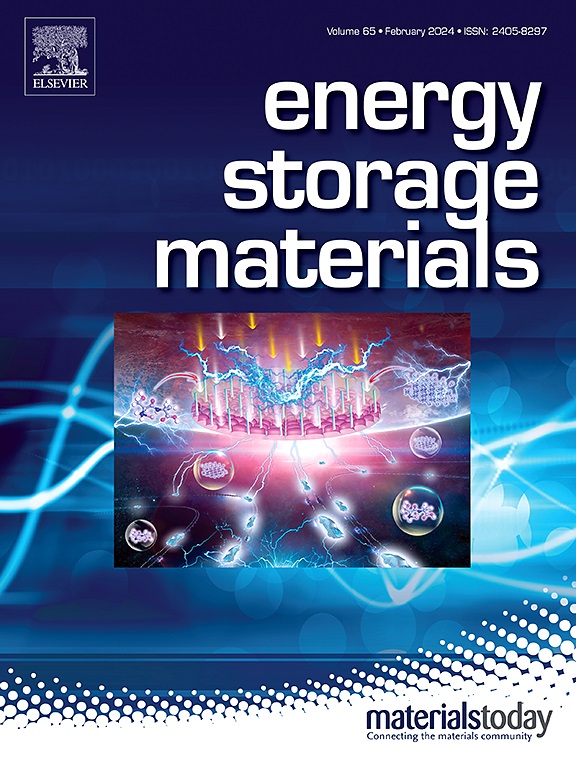Ultrasound-Driven Fibrous MXene and Graphene Formation via Molecular Interactions for Asymmetric Supercapacitors with Enhanced Charge Storage
IF 18.9
1区 材料科学
Q1 CHEMISTRY, PHYSICAL
引用次数: 0
Abstract
Asymmetric supercapacitors (ASCs) based on 2D nanomaterials hold great promise for high-performance energy storage, yet challenges remain in ion transport and self-discharge. This work presents a facile and scalable ultrasound-driven strategy, utilizing ascorbic acid (AA), to fabricate fibrous architectures of Ti3CNTx MXene and reduced graphene oxide (rGO) for ASC electrodes. Molecular interactions, induced by AA and sonication, facilitate the self-assembly of nanosheets into interconnected fibrous networks with large pores, enhancing ion diffusion. Crucially, AA surface engineering reduces surface hydroxyl groups on MXene, increasing its potential of zero charge (PZC) and effectively suppressing self-discharge. The resulting Ti3CNTx-1.5AA-20//rGO-2.0AA-30 ASC exhibits significantly enhanced charge storage, achieving a high capacitance and excellent rate capability. Remarkably, it demonstrates a low self-discharge rate (15.53% voltage drop after 5000 s), attributed to the mitigated diffusion and Faradaic processes. This strategy proves versatile across various aqueous electrolytes (H2SO4, LiCl, KOH) and yields ASCs with excellent cycling stability and a high energy density of 19.7 mWh g-1. This approach offers a promising route for next-generation supercapacitors with improved energy storage and charge retention.

超声驱动纤维MXene和石墨烯通过分子相互作用形成具有增强电荷存储的非对称超级电容器
基于二维纳米材料的非对称超级电容器(ASCs)在高性能储能方面具有很大的前景,但在离子传输和自放电方面仍存在挑战。这项工作提出了一种简单且可扩展的超声波驱动策略,利用抗坏血酸(AA)来制造用于ASC电极的Ti3CNTx MXene和还原氧化石墨烯(rGO)的纤维结构。AA和超声诱导的分子相互作用促进纳米片自组装成具有大孔的互连纤维网络,增强离子扩散。最重要的是,AA表面工程减少了MXene表面的羟基,增加了它的零电荷电位(PZC),有效地抑制了自放电。所得的Ti3CNTx-1.5AA-20//rGO-2.0AA-30 ASC具有显著增强的电荷存储能力,实现了高电容和优异的倍率性能。值得注意的是,由于减缓了扩散和法拉第过程,它的自放电率很低(5000 s后电压下降15.53%)。事实证明,该策略适用于各种水溶液电解质(H2SO4、LiCl、KOH),并产生了具有优异循环稳定性和19.7 mWh g-1高能量密度的ASCs。这种方法为下一代超级电容器提供了一条有前途的途径,可以改善能量储存和电荷保持。
本文章由计算机程序翻译,如有差异,请以英文原文为准。
求助全文
约1分钟内获得全文
求助全文
来源期刊

Energy Storage Materials
Materials Science-General Materials Science
CiteScore
33.00
自引率
5.90%
发文量
652
审稿时长
27 days
期刊介绍:
Energy Storage Materials is a global interdisciplinary journal dedicated to sharing scientific and technological advancements in materials and devices for advanced energy storage and related energy conversion, such as in metal-O2 batteries. The journal features comprehensive research articles, including full papers and short communications, as well as authoritative feature articles and reviews by leading experts in the field.
Energy Storage Materials covers a wide range of topics, including the synthesis, fabrication, structure, properties, performance, and technological applications of energy storage materials. Additionally, the journal explores strategies, policies, and developments in the field of energy storage materials and devices for sustainable energy.
Published papers are selected based on their scientific and technological significance, their ability to provide valuable new knowledge, and their relevance to the international research community.
 求助内容:
求助内容: 应助结果提醒方式:
应助结果提醒方式:


